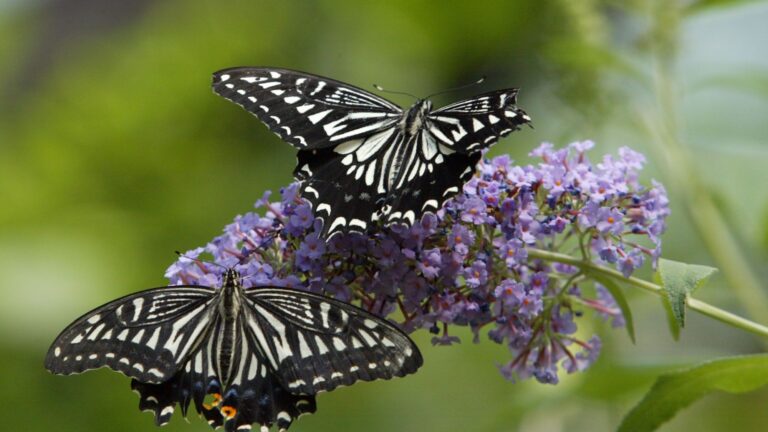Ask the Gardener: Perennials that deer don’t like but you will
Award-winning garden writer Carol Stocker tells you want to do in the garden this week and suggests shade-tolerant ground covers.

What to do this week: Buy potted chrysanthemums that are still mostly buds. Instead of planting them (they won’t survive the winter), stick their pots in attractive outdoor containers such as urns for added height.
Lawns should be fertilized organically once a year between now and November. More often than that just weakens grass and causes nitrogen runoff that pollutes watersheds. Stop fertilizing all other plants so they can prepare for dormancy.
Bring houseplants indoors after spraying them (outdoors) with insecticidal soap.
Plant evergreens now through October, but plant other trees and shrubs after the leaves drop.
Q. I have referred to my hosta bed as the “Bambi Café’’ ever since a large deer and her offspring became frequent visitors. I have chased them off several times and continue to spray Deer B Gon, but they come when I am not around. Is there a spray that works best? Will the eaten hostas grow back next year? Are there varieties of hosta deer do not like?
MARY ALICE GALLAGHER, Milton
A. I think Bambi loves all hostas (and tulip buds and yews). Hostas off their beaten path along a busy road or tucked under your kitchen window may be overlooked. Hostas will certainly re-sprout for many springs before giving up and saying “hosta la vista!’’ I have successfully sprayed with Deer Out. I think it’s important to change up deterrent sprays, but I’ve gradually replaced most of my hosta with other shade-tolerant ground covers less appealing to deer, such as hellebores, epimediums, Mayapples, bloodroot, perennial geraniums, bleeding hearts, astilbe, Japanese wood peonies, grapeleaf anemone, lobelia, European and American ginger, ferns, lamium, Japanese forest grass, and pulmonaria. There are a lot of options.
I see that you also live in Milton, which I call “Deertopia’’ because of Blue Hills Reservation. But the deer seem less brazen about trespassing into my garden since the introduction of a limited hunting season. Maybe that’s the ultimate deterrent.
Q. You have long promoted cutting back and thinning phlox, so this year I did it in early July. It has been a failure. We were in Maine for three weeks and returned to find phlox with few leaves, mainly at the top, and few, if any, flowers. They were so ugly I cut them down. What did I do incorrectly?
D.F., Concord
A. Many people think phlox are easy to grow because, like tawny day lilies, they’re found in old gardens thriving on neglect. But those are usually tough wild seedlings that have reverted to magenta after crowding out their fainthearted hybrid parents. Those beautiful pink, purple, and white hybrids are really surprisingly high-maintenance, demanding plenty of air circulation through thinning, supplemental watering of the roots (but not the leaves), deadheading, and thorough cleanup in the fall to prevent diseases from wintering over in dead leaves. After all that, phlox still require the good luck of a relatively rainy but low-humidity summer. We were blessed with one this year — until August. Then I had to water. But my phlox still had a spectacular year.
What went wrong with yours? Maybe you were away when they bloomed or when they needed watering. No matter what, phlox foliage usually looks awful as the blooms peter out, a trait it shares with many: day lilies, bearded iris, hollyhocks, columbine, heliopsis, and some other perennials. After these finish flowering, I often cut them down completely to keep the garden looking comely rather than collapsed in the fall. Some sprout clean new foliage, while others wait until spring. Don’t be afraid to cut down a bad-looking plant. I’m chopping all my phlox now, though they haven’t quite finished blooming. They just don’t look good anymore. My advice is to experiment by cutting back and thinning only some of your phlox next year before July 4. Then water, water, water. Try moving them to a sunnier spot or adding more disease-resistant varieties. “David’’ is the best grower, but I find it too blindingly white and tall to combine with other phlox varieties, so I grow it separately. Many excellent gardeners think phlox is not worth the trouble, especially if they go away in the summer when it blooms, but I like this native wildflower — and so do the hummingbirds and butterflies.

Exhibit
A century ago, the majestic American chestnut tree became the first cornerstone species in our forests wiped out by a foreign pest. Now our towering evergreen American hemlock is fighting for its life against a tiny aphid-like insect from Japan called the woolly adelgid. “Hemlock Hospice’’ is an indoor-outdoor exhibition about this struggle that blends art and science with a trail of woodland sculptures, as well as prints, drawings, and sculptures. It runs from this Oct. 7 through Nov. 18, 2018. The opening reception will be held on Saturday, Oct. 7, from noon to 4 p.m. at the Fisher Museum at Harvard Forest (324 N. Main St., Petersham). For more information and to RSVP, visit harvardforest.fas.harvard.edu/hemlock-hospice or call 978-724-3302. The artist, David Buckley Borden, is working in collaboration with Aaron Ellison, senior research fellow in ecology at Harvard University, who just e-mailed me via satellite in the Amazon basin. Go rainforests! Go hemlocks! The world needs both of you.
Send questions and comments, along with your name/initials and community to [email protected]. Subscribe to our newsletter at pages.email.bostonglobe.com/AddressSignUp.






Conversation
This discussion has ended. Please join elsewhere on Boston.com